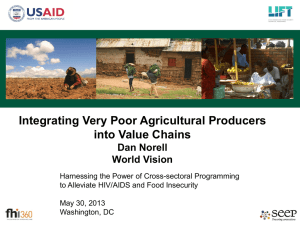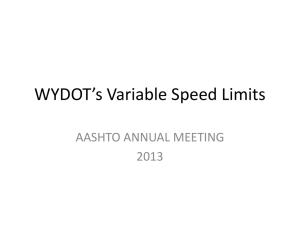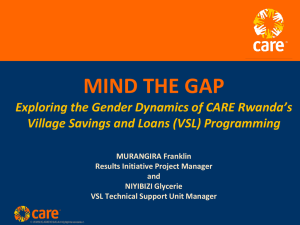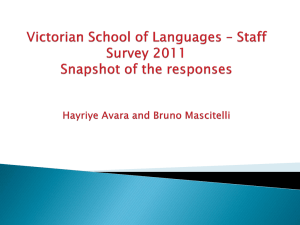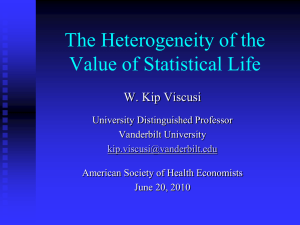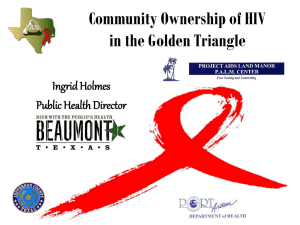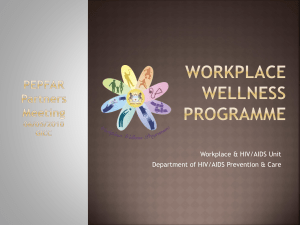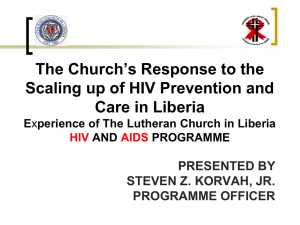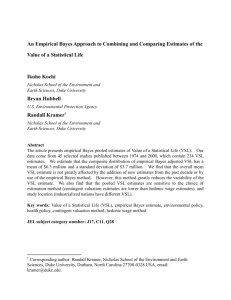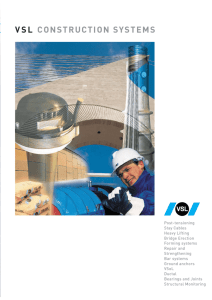Ntongi-McFadyen-Building-Savings-and-Protecting-Assets
advertisement
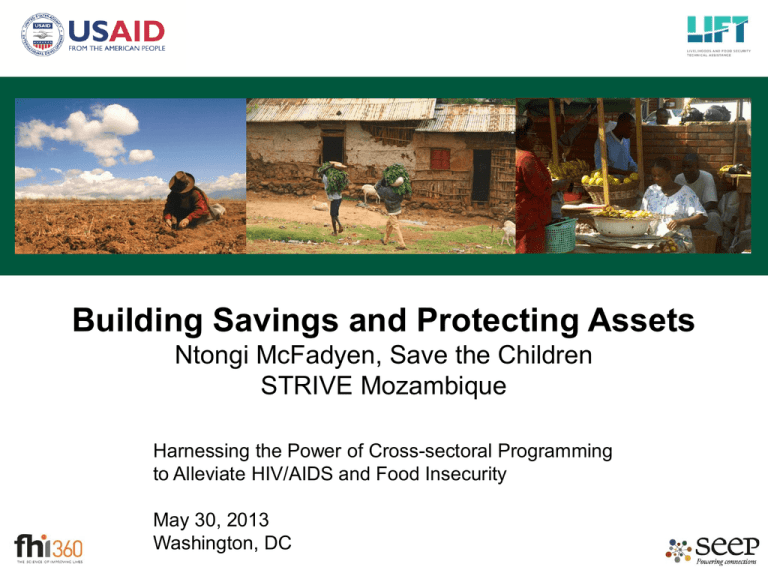
Building Savings and Protecting Assets Ntongi McFadyen, Save the Children STRIVE Mozambique Harnessing the Power of Cross-sectoral Programming to Alleviate HIV/AIDS and Food Insecurity May 30, 2013 Washington, DC Harnessing the Power of Cross-sectoral Programming to Alleviate HIV/AIDS and Food Insecurity STRIVE Mozambique context • Chronic food insecurity and child malnutrition • Nampula Province: – 63% of children under 5 chronically malnourished – Smallholder, subsistence-oriented farming – Hunger season from December to March Harnessing the Power of Cross-sectoral Programming to Alleviate HIV/AIDS and Food Insecurity Program activities • STRIVE activities implemented in 2008-2012: –Village Savings and Loan (VSL) groups –Rotating labor scheme, Ajuda Mutua (AM) • 10,000+ participants in VSL groups - potential to impact more than 25,000 children • Overlay with SANA, a USAID Title II food security program addressing nutrition, agriculture, and disaster risk reduction. Harnessing the Power of Cross-sectoral Programming to Alleviate HIV/AIDS and Food Insecurity Impact evaluation • To assess program effect on: – HH food security, HH and child food diversity, and child anthropometric measures – Intermediary outcomes: income, assets and social capital • Household cohort survey: – August 2009 and August 2012 – 9.1% attrition rate – 1543 program beneficiaries and residents of the comparison group area Harnessing the Power of Cross-sectoral Programming to Alleviate HIV/AIDS and Food Insecurity Nampula Province Erati No VSL, No AM Memba No VSL, No AM No VSL, No AM (Control) Nacala Velha VSL Only VSL Only Mossuril VSL Only Ajuda Mutua Only VSL + Ajuda Mutua Meconta Ajuda Mutua Mogincual VSL + AM Angoche VSL + AM Moma Ajuda Mutua Harnessing the Power of Cross-sectoral Programming to Alleviate HIV/AIDS and Food Insecurity Qualitative follow-up study • To explore factors leading to the change in outcomes • Subsample of households from impact evaluation with measured improvements in income and social capital • In-depth interviews conducted in Nov-Dec 2012 – 43 VSL participants in Mossuril district – 42 VSL&AM participants in Angoche district Harnessing the Power of Cross-sectoral Programming to Alleviate HIV/AIDS and Food Insecurity Results overview VSL AM VSL+AM Household Income per capita + + + Assets* + + + Mos. of adequate food** + + + Food diversity (FCS) + Not sig. Not sig. + Not sig. Not sig. Stunting Not sig. - - Wasting Not sig. Not sig. Not sig. Underweight Not sig. Not sig. Not sig. (+) = better than control Child Food diversity (FCS) *aluminum panels, toilets Harnessing the Power of Cross-sectoral Programming to Alleviate HIV/AIDS and Food Insecurity (-) = worse than control Difference in Difference design Effect of participation = Difference for VSL group – Difference for comparison group VSL Effect of participation Comparison Group Difference for comparison group Difference for VSL group ‘Counterfactual’ for VSL Group What would have happened in absence of treatment Baseline (2009) Time End Line (2012) Harnessing the Power of Cross-sectoral Programming to Alleviate HIV/AIDS and Food Insecurity Results Income and Assets VSL vs. Control Total per capita Income 1,000 Mzn = $38 VSL Comparison Group Total Durable Assets VSL †DD = .85*** (log. scale); Ratio of difference is 2.3 Baseline (2009) Comparison Group †DD = 1.124*** Endline (2012) † Propensity score weighted difference in difference, controlling for natural shocks Harnessing the Power of Cross-sectoral Programming to Alleviate HIV/AIDS and Food Insecurity Results Food Security and Dietary Diversity VSL vs Control Mo. Adequate Food VSL Dietary Diversity (FCS) Comparison Group VSL †DD = .416*** Comparison Group †DD = .889*** Baseline (2009) Endline (2012) † Propensity score weighted difference in difference, controlling for natural shocks Harnessing the Power of Cross-sectoral Programming to Alleviate HIV/AIDS and Food Insecurity Key drivers of impact • Income – Men have a central decision-making role in allocating savings and loans, although women participation is more dominant in VSL – Use of loans to invest in agriculture and business; large changes in income driven by investment in high value crops – Exposed to business training but sense of limited non-farm opportunities; no apparent income gains from livestock • Assets – Households acquiring a range of durable assets (improved toilets, aluminum and zinc panels, bicycles, clocks, radios, etc) – Given a lump sum, are durable assets an easy and low risk purchase? Or are they a preference? Harnessing the Power of Cross-sectoral Programming to Alleviate HIV/AIDS and Food Insecurity Key drivers of impact • Food security – – – – Share-out almost always timed to align with the hunger season Women referred to making food and daily needs purchases Men referred to making agriculture and durable good investments Members associated dietary diversity with desire for variety in tastes, rather than nutritional quality • Child anthropometrics (stunting, wasting, underweight) – Some VSL members exposed to nutrition messages through SANA; acknowledgement of different food needs among children and equity in intra-household distribution of food – In hierarchy of needs, potential investment in children’s nutrition appears to be crowded out by other priority needs Harnessing the Power of Cross-sectoral Programming to Alleviate HIV/AIDS and Food Insecurity Questions Harnessing the Power of Cross-sectoral Programming to Alleviate HIV/AIDS and Food Insecurity Implications going forward VSL - overlayed with SANA - was not enough to improve health and nutrition outcomes for children, in this context: – Would the explicit integration of health and nutrition within VSL yield nutritional outcomes for children? Is the problem not a priority or is the solution not well understood? – Would increased engagement of resource gatekeepers (men, grandmothers) change allocations to prioritize nutritional needs? VSL contributed to income, asset, and risk mitigation gains: – Would children’s nutritional needs eventually compete for finite resources as households work their way through priority expenditures? Can VSL achieve this, and under what timeframe? – What additional avenues can accelerate outcomes, e.g., readily available nutritional foods at a lower cost? In other contexts, how has VSL shown to have built and protected assets? Harnessing the Power of Cross-sectoral Programming to Alleviate HIV/AIDS and Food Insecurity
